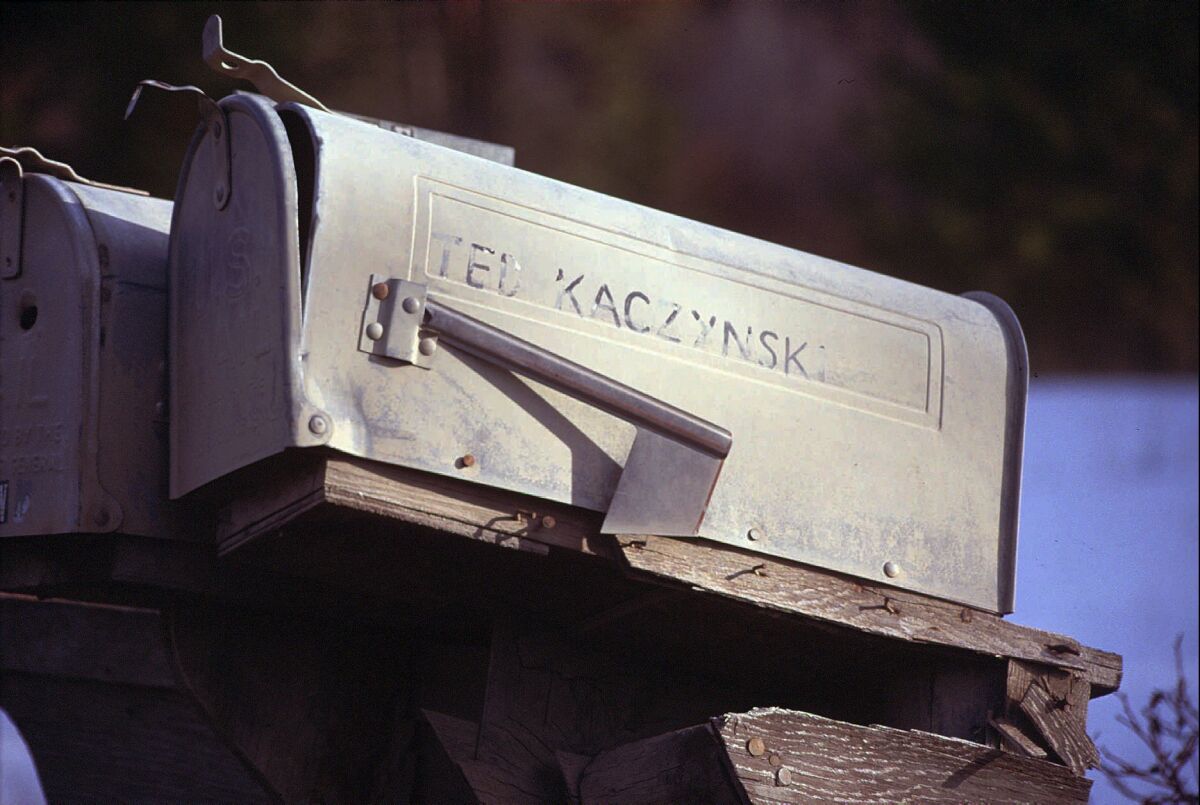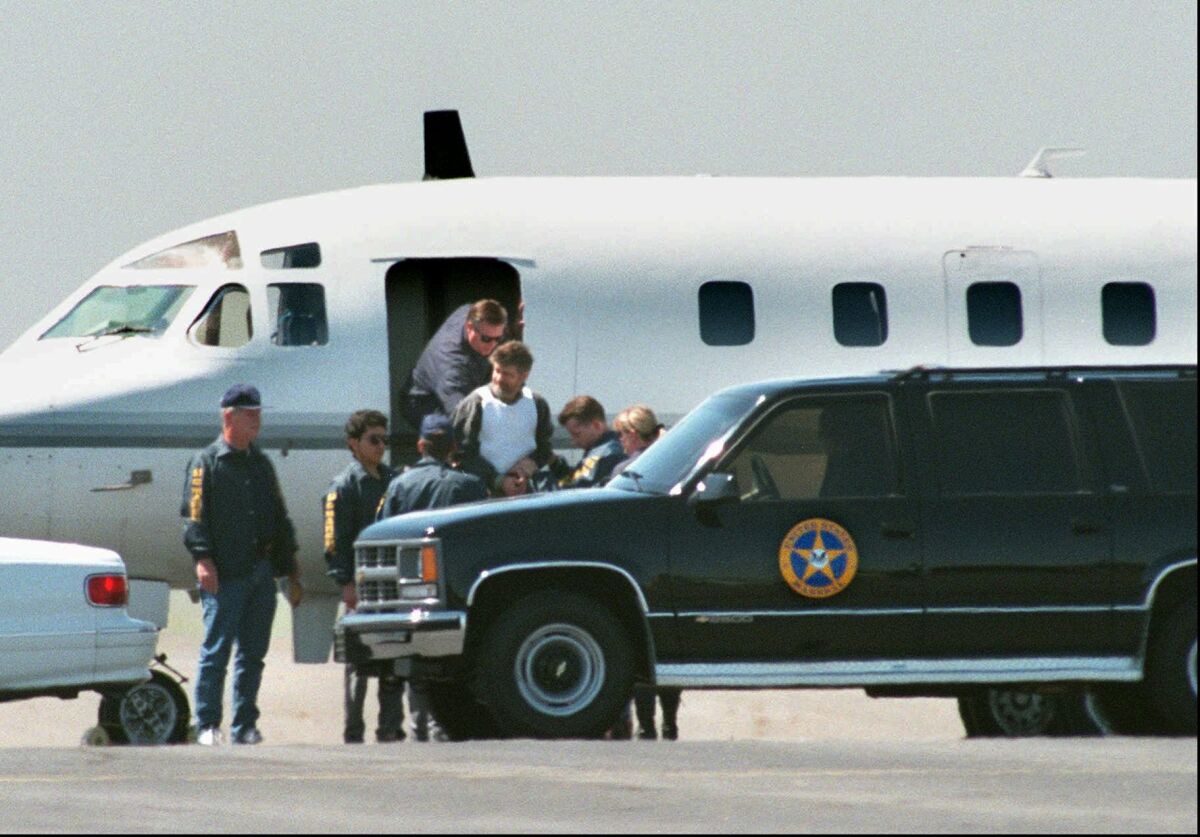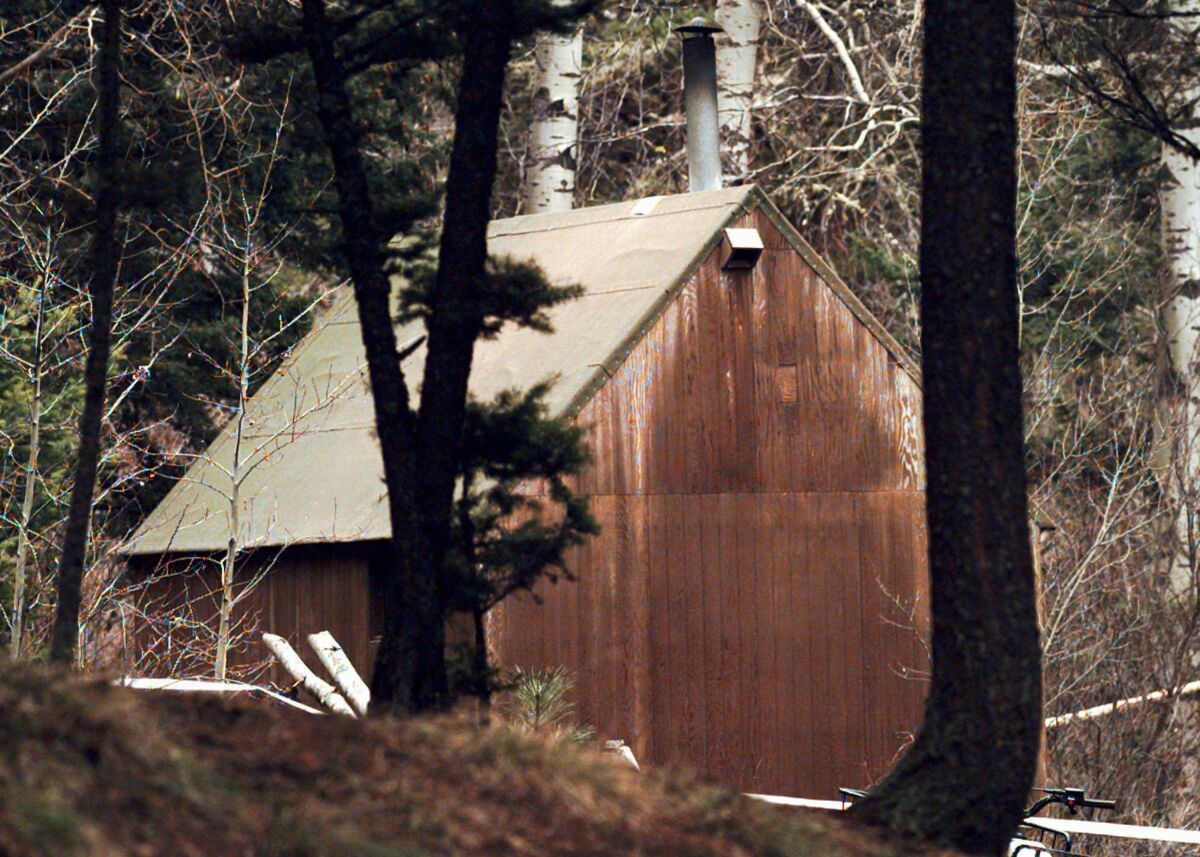At first the bombs were crude affairs, amateur efforts packed with thousands of match heads. But over time, Ted Kaczynski became a craftsman, building sophisticated killing devices from easily obtained chemicals, lamp cords, roofing nails — materials that were commonplace, highly damaging and virtually untraceable.
When he needed switches, he hand-carved them from hickory. He glued components together with epoxy that he made from the boiled hooves of deer he shot. In his primitive, 10-by-12-foot cabin near the Continental Divide in Montana, he sanded and filed and polished parts to erase his fingerprints. He even peeled the skin off batteries to eliminate the lot numbers that could identify where they were sold.
He fed investigators false clues, taunting them like a comic-book villain. He sent the New York Times a letter with a return address of 9th Street and Pennsylvania Avenue N.W. in Washington, D.C., — the location of the J. Edgar Hoover Building, headquarters of the FBI. At one point, he lodged hairs he found in a bus station restroom between the layers of electrical tape on a bomb’s wire connections, hoping to initiate a genetic wild-goose chase.
But in 1996, after 18 years of a frightening, slow-motion rampage that killed three people and injured 23 more, Kaczynski was finally arrested — betrayed not by his bombs but by his own words.
Known as the Unabomber, Kaczynski died Saturday in federal prison, a spokesperson for the Bureau of Prisons told the Associated Press. He was 81.
Kaczynski was found dead around 8 a.m. at a prison medical facility in North Carolina, where he had been moved to in 2021. A cause of death was not immediately known.
By the time of his capture, Kaczynski had become one of the most feared individuals in America. The FBI poured more than $50 million into tracking him down and offered a $1-million reward for information leading to his conviction. In the end, more than 150 FBI agents, profilers, analysts and others were working full time on finding the terrorist who had eluded them for so many years.
Kaczynski’s Unabomber moniker came from an FBI code name combining the “un” of universities and the “a” of airlines, his initial targets. His identity first emerged just two months before his arrest. In his writings, the taciturn hermit referred to himself as FC — for “Freedom Club” — and grandiosely used the first-person plural to suggest it was a group of like-minded comrades.
A Harvard graduate and a former math professor at UC Berkeley, Kaczynski wanted above all to draw attention to his ideas, all radiating from his hatred of modern technology. In a 1995 letter, he vowed to suspend his killings if the New York Times or Washington Post published, unedited, his 35,000-word treatise on the dehumanizing influence of technology. The manifesto, as it was known, began: “The Industrial Revolution and its consequences have been a disaster for the human race.”
It was published as an eight-page special section in the Washington Post on Sept. 19, 1995. Its themes of technology running amok and individual freedom shrinking were familiar, but parts of the Unabomber’s opus were chilling.
In paragraph 96 of his 232 paragraphs — he numbered them, for ease of reference — he honed in on the terrifying method of his madness: “If we had never done anything violent and had submitted the present writings to a publisher, they probably would not have been accepted,” he wrote. “In order to get our message before the public with some chance of making a lasting impression, we’ve had to kill people.”

Ted Kaczynski’s mailbox outside Lincoln, Mont., is shown in 1996.
(Stuart S. White / Associated Press)
In 1985, Kaczynski’s first lethal bomb killed Hugh Scrutton, the owner of a computer store in Sacramento. In 1994, public relations executive Thomas Mosser was killed as he opened one of Kaczynski’s packages at his home in North Caldwell, N.J. The following year, California Forestry Assn. President Gilbert R. Murray was killed the same way at his group’s Sacramento headquarters.
But in addition to the fatalities, Kaczynski tallied many more injuries and some grim near-misses.
In 1978, a bomb left in a parking lot ended up injuring campus officer Terry Marker at Northwestern University in Evanston, Ill. The following year, a graduate researcher at Northwestern, John Harris, was hurt in a student lounge when he opened what appeared to be a gift box.
Kaczynski was disappointed when he read that the student was treated only for cuts.
“I had hoped that the victim would be blinded or have his hands blown off or be otherwise maimed,” he wrote in a journal entry.
Later in 1979, Kaczynski placed a bomb on an American Airlines flight from Chicago to Washington, D.C. It failed to explode but thick smoke forced an emergency landing. Twelve of those aboard were treated for smoke inhalation.
He caused a fleeting panic in 1995, when he threatened to bring down an airliner leaving Los Angeles International Airport within six days. The next day, he took it all back. “Since the public has a short memory, we decided to play one last prank to remind them who we are,” he said in a letter to the New York Times. “But — no, we haven’t tried to plant a bomb on an airline [recently].”
In all, he distributed 16 bombs, either dropping them off in person or mailing them from distant cities.
His bombs injured United Airlines President Percy Wood and John Hauser, an Air Force captain and aspiring astronaut.
They hurt Janet Smith, a secretary at Vanderbilt University in Nashville; Diogenes Angelakos, an engineering professor at UC Berkeley; University of Michigan psychology professor James V. McConnell and his assistant Nicklaus Suino; and Salt Lake City computer store owner Gary Wright.
The Unabomber’s final survivors were Dr. Charles Epstein, a leading U.S. geneticist who taught at UC San Francisco, and David Gelernter, a prominent computer scientist at Yale.
Kaczynski sent Gelernter an insulting note two years after his bomb shattered the Yale professor’s right hand and nearly took out one of his eyes.
“People with advanced degrees aren’t as smart as they think they are,” he wrote. “If you’d had any brains, you would have realized that there are a lot of people out there who resent bitterly the way techno-nerds like you are changing the world and you wouldn’t have been dumb enough to open an unexpected package from an unknown source.”
Gelernter, also a painter and a political commentator, forwarded the letter to the FBI without reading it. “If this guy has a message for me, I don’t give a damn what it is,” he told agents.
Unlike other serial bombers, Kaczynski was not out to avenge perceived mistreatment by a particular individual, company or government agency. Instead, his wrath was directed at all those who enabled the operation of what he called “industrial society.” As he opined in paragraph 79 of his treatise: “It would be better to dump the whole stinking system and take the consequences.”
Born May 22, 1942, Theodore John Kaczynski grew up in Evergreen Park, Ill., a Chicago suburb. His father, Theodore R. Kaczynski, was a sausage maker, and his mother, Wanda Kaczynski, a full-time mom. They quickly recognized his brilliance and tried to nurture it, discussing Scientific American magazine articles with him when he was young. His dad loved the outdoors and taught his two sons camping skills.
Young Ted skipped two grades without much effort. In high school, his math teacher said Ted was likely the smartest student he’d ever seen. He had no friends, but joined the coin club, played trombone in the school band and got into Harvard on a scholarship.
In his university days, he was known mostly as a recluse. “I don’t recall more than 10 words being spoken by him,” Patrick S. MacIntosh, one of Kaczynski’s roommates for three years, told the Boston Globe.
“His room was an unholy mess, the worst mess I’ve ever seen in my life,” MacIntosh said. “Sometimes it smelled like he had left his lunch in there for weeks.”

Ted Kaczynski, center, is led from a plane by federal authorities at Mather Field in Rancho Cordova, Calif., in 1996.
(Dick Schmidt / Associated Press)
Kaczynski’s brilliance, however, was unquestioned.
A math major, he was admitted to a graduate program at the University of Michigan, where he received his doctorate in 1967. His dissertation won a prize as thesis of the year. Without the assistance or knowledge of his professors, he published papers in respected journals.
“Ted was quietly solving open problems and creating new mathematics,” Joel H. Shapiro, a Michigan classmate, told the Los Angeles Times. “It was as if he could write poetry while the rest of us were struggling to learn grammar.”
In 1967, he signed on as an assistant professor at UC Berkeley. Two years later, he resigned. While he had never been active in Vietnam War protests, he told a family friend he didn’t want to be part of “the war machine.” But from the cabin he built on land purchased with his brother, David, for $2,100, he pursued his own private war.
For 25 years, Kaczynski lived three miles from Lincoln, Mont., without electricity or running water. He got around on a rickety bicycle. His beard went halfway down his chest, and he was perennially disheveled. He spoke with few of the locals, though he sometimes rode along with a neighbor to bus stations in Helena or Missoula, secretly carrying his dangerous cargo in wrapped, intricately made wooden boxes.
Nobody had sensed that he was violent, but by the 1990s, doubts were stirring among those who knew him best.
In increasingly blistering letters, he had estranged himself from his family. When his father, suffering from terminal cancer, took his own life in 1990, Ted refused to attend the funeral.
David, a social worker in Schenectady, N.Y., was concerned about his older brother’s mental state and so was his wife, Linda Patrik, a philosophy professor at Union College. It was Patrik who persuaded her husband to read the Unabomber’s newly released manifesto. In their five years of marriage, she had never met her husband’s brother, but she was familiar with his long, rambling letters, typically laden with fearful forecasts about technology.
Some of the similarities between the manifesto and Ted’s writings were startling. When David saw the phrase “cool-headed logicians” in the manifesto, his heart sank. Kaczynski had used the same phrase in one of his letters.
David also was disquieted by his brother’s familiarity with the places that had been targeted by the Unabomber. Chicago, the University of Michigan, Berkeley, Salt Lake City: All were spots that Kaczynski knew well.
Ultimately, he came to an anguished dilemma: “Do nothing and run the risk that Ted might kill again, or turn him in and accept the likelihood that he would be executed for his crimes.”
After the manifesto’s publication, the FBI received some 55,000 tips on who the Unabomber might be. Offered through an attorney, David Kaczynski’s tip about his brother hit home. He later donated most of his $1-million FBI reward to his brother’s victims.
Consulting with a Georgetown University linguist, FBI profiler James R. Fitzgerald led a team that scoured the manifesto and Ted Kaczynski’s old letters to his family.
The first similarity to strike Fitzgerald was: “You can’t eat your cake and have it too” — an uncommon version of the maxim “You can’t have your cake and eat it too.” His team found some 600 distinctive phrases used in both the manifesto and the letters, including words like “wilfully,” that were spelled in the style used by the Chicago Tribune when Kaczynski was growing up.
On April 3, 1996, a legion of FBI agents and law enforcement personnel surrounded the Unabomber’s cabin off Humbug Contour Road. A U.S. Forest Service ranger and two agents pretending to be land surveyors knocked at the door. Within seconds, the Unabomber was in custody.

For 25 years, Ted Kaczynski lived in a cabin three miles from Lincoln, Mont., without electricity or running water.
(Elaine Thompson / Associated Press)
In a days-long search of the property, investigators found thousands of journal pages, bomb diagrams, technical data on bomb chemistry, two typewriters and shelves of bomb-making materials. Kaczynski’s bed was a plywood platform suspended from the wall. It had no mattress, because, as he once told his brother, mattresses make men weak. Beneath the bed was a live bomb, awaiting its next victim.
On Jan. 21, 1998, before a federal judge in Sacramento, Kaczynski pleaded guilty to murder and all other federal charges. The plea spared him the possibility of a death sentence.
Years later, he responded to a questionnaire from organizers of his 50th alumni reunion at Harvard. He described his occupation as “prisoner” and noted his awards: “Eight life sentences, issued by the United States District Court for the Eastern District of California, 1998.”
Kaczynski spent most of his time behind bars in solitary confinement at the federal Administrative Maximum Facility — also known as Supermax, near Florence, Colo. Housed in a 12-by-7-foot cell only slightly smaller than his cabin, he was allowed out into a cement courtyard for just one hour a day. For a time, his companions on his workout break, each enclosed in a large wire cage, were Oklahoma City bomber Timothy McVeigh and World Trade Center bomber Ramzi Ahmed Yousef.
Kaczynski kept himself busy with correspondence. He periodically donated the hate mail addressed to him — as well as his many exchanges with fans — to a special collection at the University of Michigan library.
He turned down nearly all interview requests. In 1999, however, he sat down with Time Magazine’s Stephen J. Dubner, who pointed out that anarchists saw him as a hero.
Kaczynski was flattered but largely unimpressed.
“A lot of these people are just irrational,” he said.
Steve Chawkins is a former Times staff writer.
Stay connected with us on social media platform for instant update click here to join our Twitter, & Facebook
We are now on Telegram. Click here to join our channel (@TechiUpdate) and stay updated with the latest Technology headlines.
For all the latest Music News Click Here
